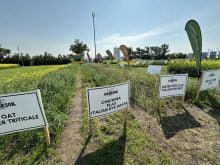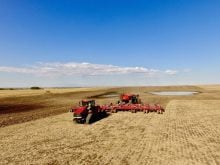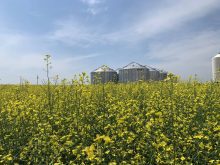With swings between wet and dry extremes in recent years, Prairie farmers have seen more water stress problems in their fields. Not only do they make crops less productive, but they can also crank up the stress levels for farmers.
“Historically, our two main risks in crop production long term have been excess moisture and drought,” says Curtis Cavers, an agronomist with Agriculture and Agri-Food Canada, who spoke on water stress risks at the CropConnect 2024 conference in Winnipeg in February.
“Of course, that makes planning for and managing these challenges very tricky because you’re dealing with one extreme or the other on the moisture spectrum.”
Read Also

Cancer agency reclassifies another herbicide ‘probably carcinogenic’
The WHO’s cancer research agency has now put atrazine, a herbicide well known to corn growers, in the same potential-hazard category where the agency put glyphosate.
Amenities such as tile drainage, irrigation systems or variable rate technology can help, he says, but they may not be affordable solutions for some producers.
Cavers, who is based at Portage la Prairie, Man., has some suggestions for managing water stress risks for farmers on a budget.
A good place for producers to start, he says, is to look for crop varieties that fare better than others in their given geographic location or risk area. He recommends referring to resources such as Seed Manitoba and other provincial seed guides, which contain valuable data on variety performance in moisture extremes.
You’ll also want to review your own records, he says, to see how different crop varieties performed under moisture stress conditions in the past.
“If farmers have yield maps of their fields, they can look to see what trends are in there from previous years,” he says. “This is probably the most helpful way to go.”
Water stress study
Cavers recently completed a research study examining whether data on varietal responses to different moisture regimes could help farmers in dealing with extremes. He shared the project findings with farmers at the CropConnect conference.
For the study, which took place at Portage la Prairie and Arborg, Man. between 2019 and 2021, multiple varieties of spring wheat and canola were grown to see how they responded to imposed excess moisture and drought conditions. This was done by measuring precipitation, monitoring moisture at different soil depths and collecting data on crop growth and yield at each field site.
Cavers collaborated with Nirmal Hari, an applied research specialist with Manitoba Agriculture based at the Prairies East Sustainable Agriculture Initiative (PESAI) Diversification Centre in Arborg, on the research project.
One significant finding was that crop type was more important than variety when it came to moisture stress responses.
Cavers says all of the varieties in the study tended to perform consistently relative to one another, regardless of the moisture conditions. In other words, if one variety was higher-yielding under normal or optimal conditions, it tended to remain higher-yielding compared to other varieties under more extreme moisture conditions.
“Conversely, from what we saw, varieties that are lower-yielding under normal conditions rarely excel in these suboptimal or unusual conditions,” Cavers says.
He views this as a testament to the work of Canadian plant breeding programs, which typically test new crop varieties over multiple years, at multiple sites, under varying moisture conditions.
“When the breeders do their selections, they’re looking at the whole scope of the data and they’re finding ones that are the most consistently high performers under a wide range of conditions, including moisture extremes.”
For this reason, he believes farmers are likely best off checking information they’ve always used, like yield potential and disease protection packages, when selecting crop varieties.
According to Cavers, understanding how different crops respond to moisture extremes can be useful when designing crop rotations. For instance, soybeans tolerate excess moisture much better than canola.
“You can see those kinds of general trends with your cereals, too. Oats do better under wet conditions, wheat and barley do better under dry.”
Cavers notes the wheat and canola in his study responded similarly and were generally in the mid-range for tolerating moisture extremes.
Strategic water management
The impact of excess moisture and drought on crops can be even more pronounced in fields with variable landscapes. As Cavers points out, farmers can take steps to reduce that risk through strategic water management.
The place to start, he says, is to gauge the topographic variability within a field and its impact on crop production.
Hilltops, for instance, tend to be droughty areas that produce generally lower yields. In lower areas where there may be excess moisture, problems like salinization or nitrogen losses through leaching and denitrification can arise.
Cavers says farmers can address these issues through agronomic actions that conserve water in high areas and use up water in low areas by such means as reducing evaporation, increasing infiltration, limiting runoff and adjusting the water table.
One such water management tool is tillage — but Cavers maintains it’s something that should be avoided in droughty parts of a field because of the erosion risk and potential loss of soil organic matter.
Farmers could consider strategic tillage in lower areas to help dry out soils, he says — and if some places are at risk of becoming particularly mucky, this has the added benefit of making fields more accessible for spraying and other timely operations.
Cavers notes cover crops can help keep evaporation down in droughty areas, though establishment can be a challenge due to lack of moisture. Cover crops that use less water are best, he says — and terminating them in a timely manner is key, because you don’t want them robbing soil moisture from a following cash crop.
In wet areas, Cavers recommends choosing a cover crop that uses a lot of water and is easily established. If it has an extensive root system as well, this can help increase moisture infiltration in the soil.
Redistributing crop residues is another way farmers can address moisture imbalances in fields with variable landscapes, he says.
“I’m going to try and put crop residues where I need them the most,” he says. That means “moving them whenever possible to those droughty areas to minimize evaporation and erosion and removing them from the wet areas to help dry those soils out a bit.”

Farmers could take this a step further, he says, and consider soil landscape restoration — a practice that helps repair eroded parts of fields through the physical relocation of topsoil from low areas, where it’s more abundant, to high areas where it’s needed most.
Cavers says using a combination of these practices should not only boost soil productivity in dry areas but also reduce nitrogen losses in wet areas.
“You’re doing this essentially with the intent of making your land productivity more uniform,” he says. “If we can better manage our carbon, our nitrogen and our water, then that will go a long way to helping us manage the landscapes in other ways on other fronts.”
















